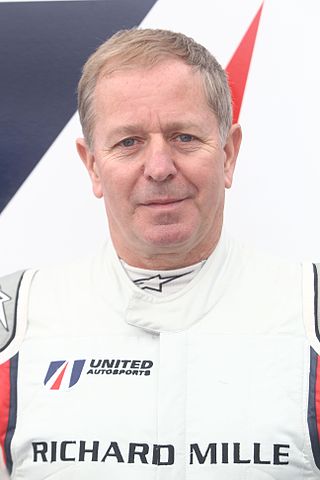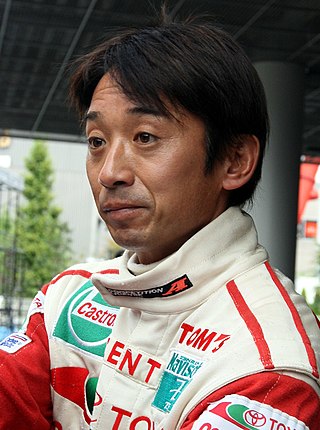
British American Racing (BAR) was a Formula One constructor that competed in the sport from 1999 to 2005. BAR began by acquiring Tyrrell, and used Supertec engines for their first year. Subsequently, they formed a partnership with Honda which lasted for the next six years.

Martin John Brundle is a British former racing driver, best known as a Formula One driver and as a commentator for ITV Sport from 1997 to 2008, the BBC from 2009 to 2011, and Sky Sports since 2012.
The Tyrrell Racing Organisation was an auto racing team and Formula One constructor founded by Ken Tyrrell (1924–2001) which started racing in 1958 and started building its own cars in 1970. The team experienced its greatest success in the early 1970s, when it won three Drivers' Championships and one Constructors' Championship with Jackie Stewart. The team never reached such heights again, although it continued to win races through the 1970s and into the early 1980s, taking the final win for the Ford Cosworth DFV engine at Detroit in 1983. The team was bought by British American Tobacco in 1997 and completed its final season as Tyrrell in 1998. Tyrrell's legacy continues in Formula One as the Mercedes-AMG F1 team, who is Tyrrell's descendant through various sales and rebrandings via BAR, Honda and Brawn GP.

Ukyo Katayama is a Japanese former racing driver and team manager, most notable for competing for six years in Formula One. He participated in 97 Grands Prix, debuting on 1 March 1992. He scored a total of five championship points, all of them for the Tyrrell team in 1994. He also competed in the 1999 24 Hours of Le Mans, finishing 2nd overall and 1st in the GTP class. He currently serves as a team representative for the Japanese continental cycling team JCL Team UKYO and has done so since 2012.

The Tyrrell P34, commonly known as the "six-wheeler", was a Formula One (F1) race car designed by Derek Gardner, Tyrrell's chief designer. The car used four specially manufactured 10-inch diameter (254 mm) wheels and tyres at the front, with two ordinary-sized wheels at the back. Along with the Brabham BT46B "fancar" developed in 1978, the six-wheeled Tyrrell was one of the most radical entries ever to succeed in F1 competition and has been called the most recognisable design in the history of world motorsports.

Johannes Franciscus Verstappen is a Dutch former racing driver who competed in Formula One for Benetton, Simtek, Footwork Arrows, Tyrrell, Stewart, and Minardi. Verstappen was the German Formula Three champion and Masters of Formula Three winner in 1993.

Jonathan Charles Palmer is a British businessman and former Formula One racing driver. Before opting for a career in motor racing, Palmer trained as a physician at London's Guy's Hospital. He also worked as a junior physician at Cuckfield and Brighton hospitals.
Ricardo Rosset is a Brazilian racing driver. Runner-up in the 1995 International Formula 3000 Championship, he later participated in 33 Formula One Grands Prix, making his debut at the 1996 Australian Grand Prix. He scored no championship points. He eventually quit Formula One to focus on developing a sportswear business in Brazil.
March Engineering was a Formula One constructor and manufacturer of customer racing cars from the United Kingdom. Although only moderately successful in Grand Prix competition, March racing cars enjoyed much better success in other categories of competition, including Formula Two, Formula Three, IndyCar and IMSA GTP sportscar racing.

Michael Robert Gascoyne is a British Formula One designer and engineer.

Harvey Ernest Postlethwaite was a British engineer and Technical Director of several Formula One teams during the 1970s, 1980s and 1990s. He died of a heart attack in Spain while supervising the testing of the aborted Honda F1 project.

The Matra MS80 was the fourth Formula One car produced by Matra. The Ford Cosworth DFV-powered car took Jackie Stewart to the Formula One World Championship title in 1969.
Mercedes AMG High Performance Powertrains is a Formula One engine manufacturer, owned by Mercedes-Benz.

The Tyrrell 003 is a Formula One (F1) racing car which was designed by Tyrrell's chief designer, Derek Gardner and used in the 1971 and 1972 F1 seasons. It was driven by Jackie Stewart to the 1971 World Drivers' Championship.

The Tyrrell 019 was a 1990 Formula One racing car, designed by a team led by Harvey Postlethwaite, and built by Tyrrell. It was an evolution of Postlethwaite's first design for Tyrrell, the Tyrrell 018.

The Tyrrell 012 is a Formula One racing car that was designed by Maurice Philippe for the Tyrrell team. It was introduced for the 1983 season, and was subsequently used in 1984 and the first few races of 1985.
Formula One sponsorship liveries have been used since the 1968 season. Before the arrival of sponsorship liveries in 1968 the nationality of the team determined the colour of a car entered by the team. Major sponsors such as BP, Shell, and Firestone had pulled out of the sport ahead of this season, prompting the Fédération Internationale de l'Automobile to allow unrestricted sponsorship. Team Gunston became the first Formula One team to implement sponsorship brands as a livery on their Brabham car, which privately entered for John Love in orange, brown and gold colours of Gunston cigarettes in the first race of the 1968 season, the 1968 South African Grand Prix, on 1 January 1968. In the next race, the 1968 Spanish Grand Prix, Team Lotus became the first works team to follow this example, with Graham Hill's Lotus 49B entered in the red, gold and white colors of Imperial Tobacco's Gold Leaf brand. With rising costs in Formula One, sponsors becoming more important and thus liveries reflected the teams' sponsors.

The Tyrrell 020 was a Formula One racing car designed by Harvey Postlethwaite and George Ryton for Tyrrell Racing and raced during the 1991 season.
The Tyrrell 017 was a Formula One racing car designed by Maurice Philippe and Brian Lisles. It was built and raced by Tyrrell Racing in the 1988 season and also for the first race of the 1989 season. It used a customer Cosworth DFZ V8 engine as had its predecessor. The car was driven in 1988 by British pair Jonathan Palmer and Formula One rookie Julian Bailey. Bailey was replaced by Michele Alboreto in 1989 as was the Cosworth DFZ replaced by the more powerful 1988 motor the Cosworth DFR.













